英语语言学2 Morphology形态学word讲义
- 格式:doc
- 大小:34.50 KB
- 文档页数:5
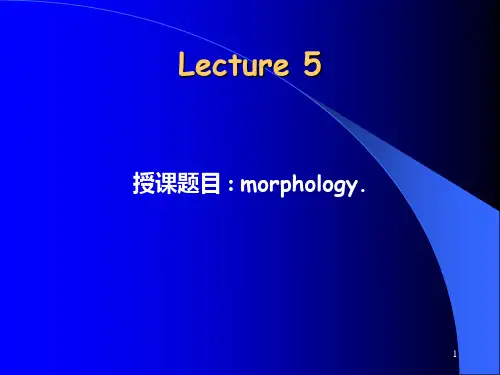
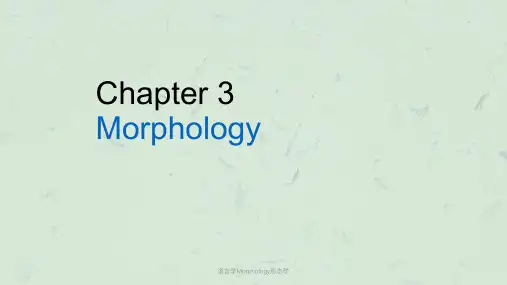
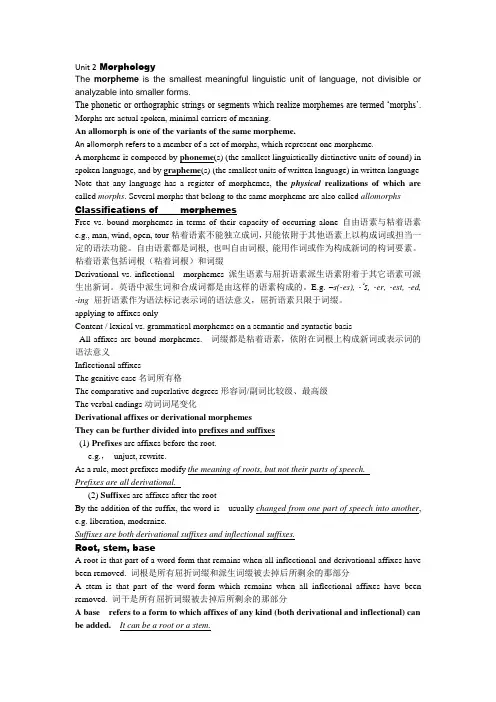
Unit 2 MorphologyThe morpheme is the smallest meaningful linguistic unit of language, not divisible or analyzable into smaller forms.The phonetic or orthographic strings or segments which realize morphemes are termed ‘morphs’. Morphs are actual spoken, minimal carriers of meaning.An allomorph is one of the variants of the same morpheme.An allomorph refers to a member of a set of morphs, which represent one morpheme.A morpheme is composed by phoneme(s) (the smallest linguistically distinctive units of sound) in spoken language, and by grapheme(s) (the smallest units of written language) in written language Note that any language has a register of morphemes, the physical realizations of which are called morphs. Several morphs that belong to the same morpheme are also called allomorphs Classifications of morphemesFree vs. bound morphemes in terms of their capacity of occurring alone 自由语素与粘着语素e.g., man, wind, open, tour粘着语素不能独立成词,只能依附于其他语素上以构成词或担当一定的语法功能。

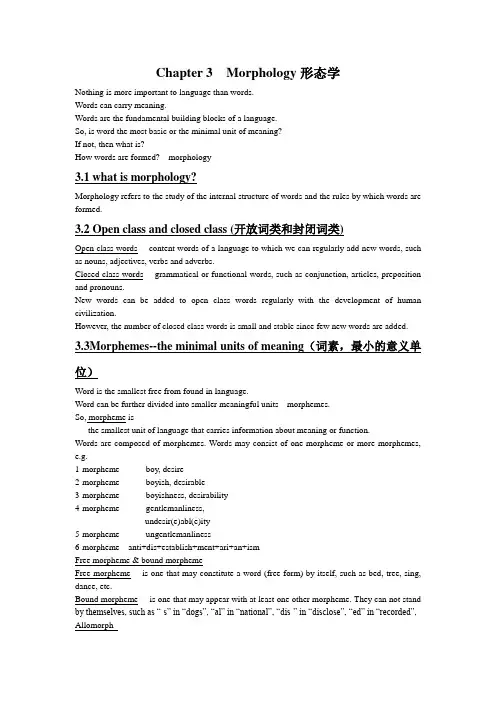
Chapter 3 Morphology形态学Nothing is more important to language than words.Words can carry meaning.Words are the fundamental building blocks of a language.So, is word the most basic or the minimal unit of meaning?If not, then what is?How words are formed?---morphology3.1 what is morphology?Morphology refers to the study of the internal structure of words and the rules by which words are formed.3.2 Open class and closed class (开放词类和封闭词类)Open class words----content words of a language to which we can regularly add new words, such as nouns, adjectives, verbs and adverbs.Closed class words----grammatical or functional words, such as conjunction, articles, preposition and pronouns.New words can be added to open class words regularly with the development of human civilization.However, the number of closed class words is small and stable since few new words are added.3.3Morphemes--the minimal units of meaning(词素,最小的意义单位)Word is the smallest free from found in language.Word can be further divided into smaller meaningful units---morphemes.So, morpheme is---the smallest unit of language that carries information about meaning or function.Words are composed of morphemes. Words may consist of one morpheme or more morphemes, e.g.1-morpheme boy, desire2-morpheme boyish, desirable3-morpheme boyishness, desirability4-morpheme gentlemanliness,undesir(e)abl(e)ity5-morpheme ungentlemanliness6-morpheme anti+dis+establish+ment+ari+an+ismFree morpheme & bound morphemeFree morpheme----is one that may constitute a word (free form) by itself, such as bed, tree, sing, dance, etc.Bound morpheme----is one that may appear with at least one other morpheme. They can not stand by themselves, such as ―-s‖ in ―dogs‖, ―al‖ in ―national‖, ―dis-‖ in ―disclose‖, ―ed‖ in ―recorded‖, AllomorphSome morphemes have a single form in all contexts, such as ―dog, bark, cat‖,etc.In other instances, there may be some variation, that is, a morpheme may have alternate shapes or phonetic forms. They are said to be the allomorphs of the morpheme.the plural morpheme may be represented by:map----maps [s]dog----dogs [z]watch----watches [iz]mouse----mice [ai]ox----oxen [n]tooth----teethsheep----sheepEach of the underlined part is called an allomorph of plural morpheme.3.4 Analyzing word structuresIdentify each of the major component morphemes.Classify these morphemes in terms of their contribution to the meaning and function of the larger word.Generally speaking, a complex word often consists of a root and one or more affixes.Root: constitutes the core of the word and carries the major component of its meaning.Roots typically belong to lexical categories such as nouns, verbs, adjectives and prepositions. Affix: is always a bound morpheme, and does not belong to a lexical category.Tree diagram (teach-er)NV Afteach er3.5 Derivational morpheme & inflectional morpheme 派生词素和屈折词素Derivational morphemes---- the morphemes which change the category, or grammatical class of words, e.g. modern---modernize, length---lengthen, fool---foolish, etc.when derivational morphemes are conjoined to other morphemes, a new word is derived or formed--- may change grammatical classeg. light –lighten; nasal –nasalize;eat—edible; grave--engrave--- may not change grammatical classeg. net---internet; happy—unhappy;national—multinational; terror-terroristMany prefixes and suffixes belong to derivational morphemeseg. tele-phone; music-ianConsider: is there any prefix or suffix which doesn’t fall into derivational morphemes? Inflectional morphemes---- the morphemes which are for the most part purely grammatical markers, signifying such concepts as tense, person, mood, voice, case, number, aspect and degree;e.g.:1) number: tables apples cars2) tense: talk/talks/talking/talked3) case: John/John’s4) degree: large/larger/largestInflectional morphemes never change lexical category, never add any lexical meaning,Morphemefree morpheme bound morphemefree root affix bound root (-ceive)derivational morpheme inflectional morphemeprefix suffixproductive morphological rulesSome of the rules can be used quite freely to form new wordseg. un + derived words (adj.) = not ---adj. [un-Rule]unimaginable unthinkable; unmentionedunbrave (×)(un-rule more productive for adj. derived from verbs than for adj. of just one morpheme like sad---unsad??)eg. sincere---sincerity; scarce—scarcity [ity –Rule]fierce---fiercity (×)(ity-Rule becomes less productive than before)Word-formationDerivation派生: the most common word-formation process, by affixationeg. Derivational + free morphemesgirlish; reliableCompounding复合(stringing words together; juxtaposition of two or more than two words to form a new, composite one with distinct properties of its own)Adj. N. V. Prep. Adj. Bittersweet clearway whitewash blackoutN. Headstrong rainbow spoon-feed head-onV. Carryall pickpocket sleepwalk cutupPrep. Inborn off-licence undertake withoutSome points about compounds1) two words in the same grammatical category, compound in this category;eg. landlord; bedroom; icy-cold;2) two words in different categories, compound in the class of second or final word;eg. pickpocket; headstrong; blackboard; swearwordcompound with preposition, nonpreposition part decideseg. undertake; uplift; overtake; oversee; overdoseexceptions: blackout ( n.) ; head-on (adv.);3) compounds have different stress patterns from non-compounded word sequence;e.g. 'blackbird & black 'bird;'washing machine'greenhouse & green 'house;red 'coat &'redcoat4) meaning of a compound not necessarily the sum of the meaning of its partsmeaning of each compound includes at least to some extent the meaning of individual partseg. reading room; a falling star; a looking glass (窥镜)meanings of compounds do not relate to the meanings of the individual parts at alleg. bigwig(要人,大亨); greenhorns (生手,不懂世故的人)highbrow(知识分子,自命不凡的人)/lowbrow(教养浅薄的人);turncoat变节者Conversion 转类构词(a change in the grammatical function of a word without adding or removing any part of it)Eg. a walk---to walk; a play---to playincrease (n.)--- increase (v.)conduct (n.) --- conduct (v.)I have no knowledge of the political dos and don’tsBackformation 反向构词(a reverse process of affixation. The word is not formed by adding a morpheme to a stem but by assuming a part of the stem as a suffix and removing it)Eg. editor --- edit; beggar --- begtelevision – televise; enthusiasm--- enthuseBorrowing外来语构词(adopting foreign words)--- loan-words借词(retaining their original phonetic or even written forms)eg. bungalow (Hindi); spaghetti (Italian);veranda (Portuguese 阳台)bok choy (Chinese baice); alcohol (Arabic)--- loan-translation or calques(直译,译借) 仿造词( a direct translation of the foreign word into English)eg. superman ---Ubermensch (German)Kongfu (Chinese)Clipping缩略构词( a reduction process in which a word of more than one syllable is reduced to a shorter form, often used in informal speech)Eg. ad--- advertisement; lab---laboratoryfan---fanatic; flu---influenza;math---mathematicsBlending混合构词(join the beginning of the first word to the end of the other words)Eg. smog (smoke + fog)brunch (breakfast + lunch)motel (motor + hotel)telecast (television + broadcast)Acronym首字构词(string together the initial letters of the words in a phrase, typically the names of technical apparatus and institutions, sometimes, the phrasal origin is lost )Eg. radar (radio detecting and ranging)AIDS (acquired immune deficiency syndrome)SARS (Severe Acute Respiratory Syndrome)APEC (Asia-Pacific Economic Cooperation)UNESCO (United Nations Educational, Scientific, and Cultural Organization)Coinage 创新构词(invention of totally new terms, least common, often brand names)eg. xerox; nylon; kleenex(面巾纸)ConclusionsMorphological rules provide means for forming new words, or coin new words (eg. hair spray, tea ceremony, space walk, etc.)Morphological rules may be productive or less productive (un-Rule) ;may become less productive with the passage of time (ity-Rule)。
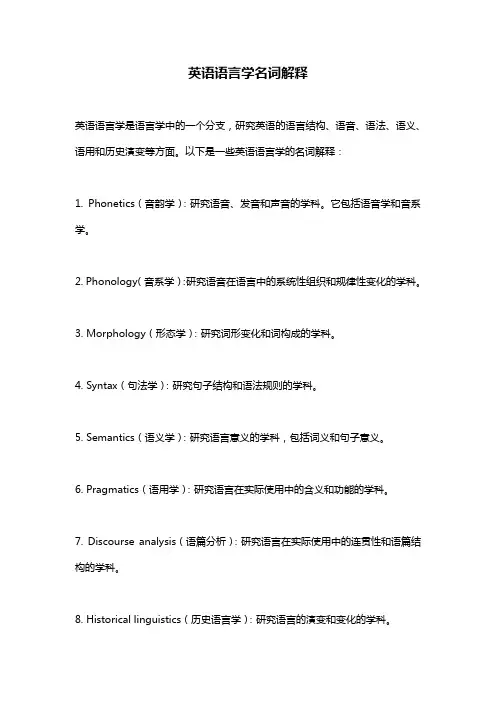
英语语言学名词解释
英语语言学是语言学中的一个分支,研究英语的语言结构、语音、语法、语义、语用和历史演变等方面。
以下是一些英语语言学的名词解释:
1. Phonetics(音韵学):研究语音、发音和声音的学科。
它包括语音学和音系学。
2. Phonology(音系学):研究语音在语言中的系统性组织和规律性变化的学科。
3. Morphology(形态学):研究词形变化和词构成的学科。
4. Syntax(句法学):研究句子结构和语法规则的学科。
5. Semantics(语义学):研究语言意义的学科,包括词义和句子意义。
6. Pragmatics(语用学):研究语言在实际使用中的含义和功能的学科。
7. Discourse analysis(语篇分析):研究语言在实际使用中的连贯性和语篇结构的学科。
8. Historical linguistics(历史语言学):研究语言的演变和变化的学科。
9. Sociolinguistics(社会语言学):研究语言和社会、文化、地理和历史等因素之间的关系的学科。
10. Psycholinguistics(心理语言学):研究语言和心理过程之间的关系的学科,包括语言习得、记忆和理解等。
以上是一些常见的英语语言学名词解释,它们涵盖了英语语言学的主要领域和分支。
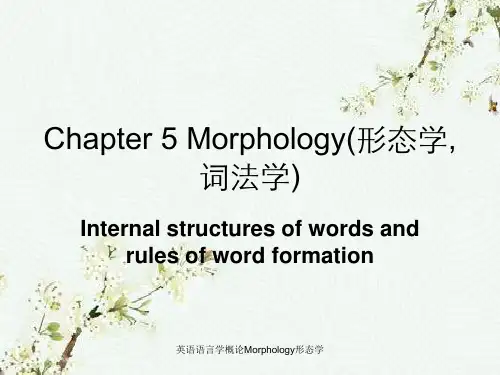
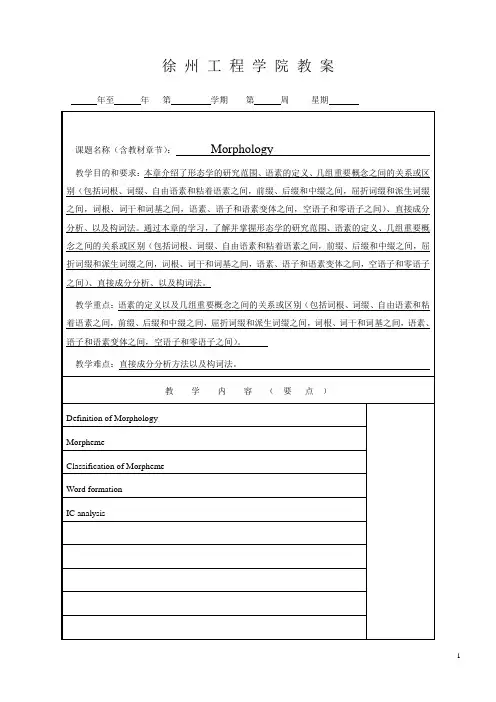
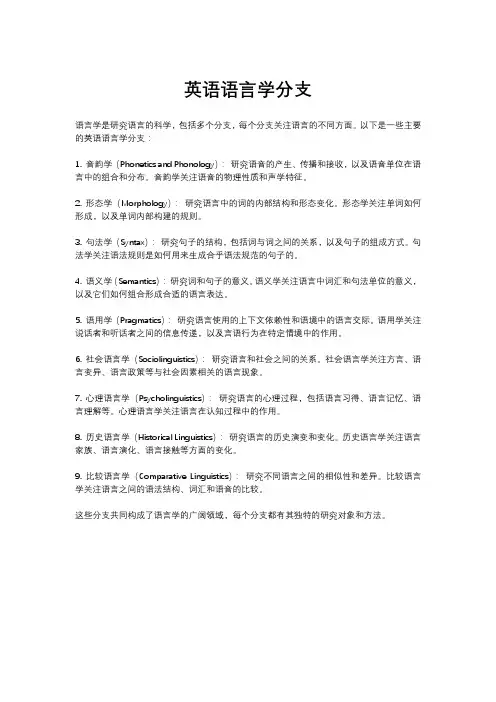
英语语言学分支语言学是研究语言的科学,包括多个分支,每个分支关注语言的不同方面。
以下是一些主要的英语语言学分支:1. 音韵学(Phonetics and Phonology):研究语音的产生、传播和接收,以及语音单位在语言中的组合和分布。
音韵学关注语音的物理性质和声学特征。
2. 形态学(Morphology):研究语言中的词的内部结构和形态变化。
形态学关注单词如何形成,以及单词内部构建的规则。
3. 句法学(Syntax):研究句子的结构,包括词与词之间的关系,以及句子的组成方式。
句法学关注语法规则是如何用来生成合乎语法规范的句子的。
4. 语义学(Semantics):研究词和句子的意义。
语义学关注语言中词汇和句法单位的意义,以及它们如何组合形成合适的语言表达。
5. 语用学(Pragmatics):研究语言使用的上下文依赖性和语境中的语言交际。
语用学关注说话者和听话者之间的信息传递,以及言语行为在特定情境中的作用。
6. 社会语言学(Sociolinguistics):研究语言和社会之间的关系。
社会语言学关注方言、语言变异、语言政策等与社会因素相关的语言现象。
7. 心理语言学(Psycholinguistics):研究语言的心理过程,包括语言习得、语言记忆、语言理解等。
心理语言学关注语言在认知过程中的作用。
8. 历史语言学(Historical Linguistics):研究语言的历史演变和变化。
历史语言学关注语言家族、语言演化、语言接触等方面的变化。
9. 比较语言学(Comparative Linguistics):研究不同语言之间的相似性和差异。
比较语言学关注语言之间的语法结构、词汇和语音的比较。
这些分支共同构成了语言学的广阔领域,每个分支都有其独特的研究对象和方法。
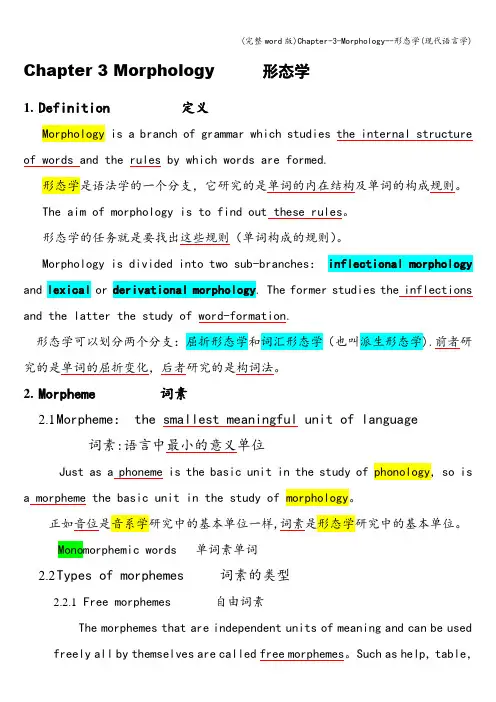
Chapter 3 Morphology 形态学1.Definition 定义Morphology is a branch of grammar which studies the internal structure of words and the rules by which words are formed.形态学是语法学的一个分支,它研究的是单词的内在结构及单词的构成规则。
The aim of morphology is to find out these rules。
形态学的任务就是要找出这些规则(单词构成的规则)。
Morphology is divided into two sub-branches:inflectional morphology and lexical or derivational morphology. The former studies the inflections and the latter the study of word-formation.形态学可以划分两个分支:屈折形态学和词汇形态学(也叫派生形态学).前者研究的是单词的屈折变化,后者研究的是构词法。
2.Morpheme 词素2.1Morpheme: the smallest meaningful unit of language词素:语言中最小的意义单位Just as a phoneme is the basic unit in the study of phonology, so is a morpheme the basic unit in the study of morphology。
正如音位是音系学研究中的基本单位一样,词素是形态学研究中的基本单位。
Monomorphemic words 单词素单词2.2Types of morphemes 词素的类型2.2.1Free morphemes 自由词素The morphemes that are independent units of meaning and can be used freely all by themselves are called free morphemes。
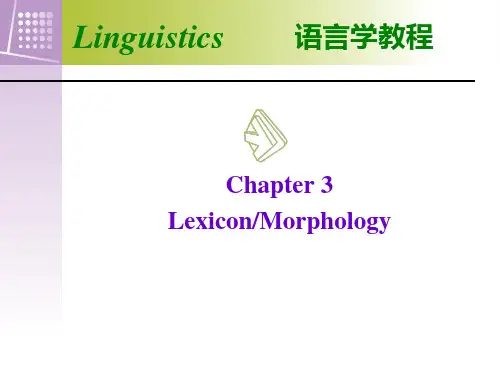
morphology语言学定义【形态学morphology】是语法学的一个分支,研究单词的内部结构和构词规则。
形态学有两个分支:曲折形态学和词汇或派生形态学。
曲折形态学研究语法曲折和语法意义的形态学;派生形态学研究单词的构成和词义的表达。
morphology什么意思?1、词法:词法研究的对象是各种词的形式及其用法. 英语词类的形式变化有:名词和代词的数,格和性的形式变化;动词的人称、时态、语态、语气等形式变化;以及形容词和副词比较等级的形式变化。
2、句法(syntax)句法研究的对象是句子各个组成部分及其安排的规律,。
3、构词学:构词学(morphology)是语言学中的一门比较简单的学问,主要研究的是词的构成. 最近几年,电脑领域的某些词汇有了一些改变,某些词汇渐渐不被人们使用,新的词汇取而代之. 例如说,以前我们说「执行」一个程式,现在则说「跑」一个程式。
资料拓展:morphology.n.形态学,形态论;词法,词态学。
短语:soil morphology土壤形态学;土壤形态。
urban morphology城市形态;城市形态学。
例句:And morphology and performance of the coating has been examined. 并对镀层的表面形貌和性能进行了测定。
We also analyzed the effect of morphology on field emission properties.我们还分析了形貌对场发射性能的影响。
He also gave a very accurate description of the morphology of his cells.他给他所发现的.细胞的形态学特征进行了非常精细的描述。
They attain complex morphology, appearing as branched, tubular processes.它们达到复杂的形态,出现分枝,管状突起。
Chapter 3 Morphology形态学Nothing is more important to language than words.Words can carry meaning.Words are the fundamental building blocks of a language.So, is word the most basic or the minimal unit of meaning?If not, then what is?How words are formed?---morphology3.1 what is morphology?Morphology refers to the study of the internal structure of words and the rules by which words are formed.3.2 Open class and closed class (开放词类和封闭词类)Open class words----content words of a language to which we can regularly add new words, such as nouns, adjectives, verbs and adverbs.Closed class words----grammatical or functional words, such as conjunction, articles, preposition and pronouns.New words can be added to open class words regularly with the development of human civilization.However, the number of closed class words is small and stable since few new words are added.3.3Morphemes--the minimal units of meaning(词素,最小的意义单位)Word is the smallest free from found in language.Word can be further divided into smaller meaningful units---morphemes.So, morpheme is---the smallest unit of language that carries information about meaning or function.Words are composed of morphemes. Words may consist of one morpheme or more morphemes, e.g.1-morpheme boy, desire2-morpheme boyish, desirable3-morpheme boyishness, desirability4-morpheme gentlemanliness,undesir(e)abl(e)ity5-morpheme ungentlemanliness6-morpheme anti+dis+establish+ment+ari+an+ismFree morpheme & bound morphemeFree morpheme----is one that may constitute a word (free form) by itself, such as bed, tree, sing, dance, etc.Bound morpheme----is one that may appear with at least one other morpheme. They can not stand by themselves, such as ―-s‖ in ―dogs‖, ―al‖ in ―national‖, ―dis-‖ in ―disclose‖, ―ed‖ in ―recorded‖, AllomorphSome morphemes have a single form in all contexts, such as ―dog, bark, cat‖,etc.In other instances, there may be some variation, that is, a morpheme may have alternate shapes or phonetic forms. They are said to be the allomorphs of the morpheme.the plural morpheme may be represented by:map----maps [s]dog----dogs [z]watch----watches [iz]mouse----mice [ai]ox----oxen [n]tooth----teethsheep----sheepEach of the underlined part is called an allomorph of plural morpheme.3.4 Analyzing word structuresIdentify each of the major component morphemes.Classify these morphemes in terms of their contribution to the meaning and function of the larger word.Generally speaking, a complex word often consists of a root and one or more affixes.Root: constitutes the core of the word and carries the major component of its meaning.Roots typically belong to lexical categories such as nouns, verbs, adjectives and prepositions. Affix: is always a bound morpheme, and does not belong to a lexical category.Tree diagram (teach-er)NV Afteach er3.5 Derivational morpheme & inflectional morpheme 派生词素和屈折词素Derivational morphemes---- the morphemes which change the category, or grammatical class of words, e.g. modern---modernize, length---lengthen, fool---foolish, etc.when derivational morphemes are conjoined to other morphemes, a new word is derived or formed--- may change grammatical classeg. light –lighten; nasal –nasalize;eat—edible; grave--engrave--- may not change grammatical classeg. net---internet; happy—unhappy;national—multinational; terror-terroristMany prefixes and suffixes belong to derivational morphemeseg. tele-phone; music-ianConsider: is there any prefix or suffix which doesn’t fall into derivational morphemes? Inflectional morphemes---- the morphemes which are for the most part purely grammatical markers, signifying such concepts as tense, person, mood, voice, case, number, aspect and degree;e.g.:1) number: tables apples cars2) tense: talk/talks/talking/talked3) case: John/John’s4) degree: large/larger/largestInflectional morphemes never change lexical category, never add any lexical meaning,Morphemefree morpheme bound morphemefree root affix bound root (-ceive)derivational morpheme inflectional morphemeprefix suffixproductive morphological rulesSome of the rules can be used quite freely to form new wordseg. un + derived words (adj.) = not ---adj. [un-Rule]unimaginable unthinkable; unmentionedunbrave (×)(un-rule more productive for adj. derived from verbs than for adj. of just one morpheme like sad---unsad??)eg. sincere---sincerity; scarce—scarcity [ity –Rule]fierce---fiercity (×)(ity-Rule becomes less productive than before)Word-formationDerivation派生: the most common word-formation process, by affixationeg. Derivational + free morphemesgirlish; reliableCompounding复合(stringing words together; juxtaposition of two or more than two words to form a new, composite one with distinct properties of its own)Adj. N. V. Prep. Adj. Bittersweet clearway whitewash blackoutN. Headstrong rainbow spoon-feed head-onV. Carryall pickpocket sleepwalk cutupPrep. Inborn off-licence undertake withoutSome points about compounds1) two words in the same grammatical category, compound in this category;eg. landlord; bedroom; icy-cold;2) two words in different categories, compound in the class of second or final word;eg. pickpocket; headstrong; blackboard; swearwordcompound with preposition, nonpreposition part decideseg. undertake; uplift; overtake; oversee; overdoseexceptions: blackout ( n.) ; head-on (adv.);3) compounds have different stress patterns from non-compounded word sequence;e.g. 'blackbird & black 'bird;'washing machine'greenhouse & green 'house;red 'coat &'redcoat4) meaning of a compound not necessarily the sum of the meaning of its partsmeaning of each compound includes at least to some extent the meaning of individual partseg. reading room; a falling star; a looking glass (窥镜)meanings of compounds do not relate to the meanings of the individual parts at alleg. bigwig(要人,大亨); greenhorns (生手,不懂世故的人)highbrow(知识分子,自命不凡的人)/lowbrow(教养浅薄的人);turncoat变节者Conversion 转类构词(a change in the grammatical function of a word without adding or removing any part of it)Eg. a walk---to walk; a play---to playincrease (n.)--- increase (v.)conduct (n.) --- conduct (v.)I have no knowledge of the political dos and don’tsBackformation 反向构词(a reverse process of affixation. The word is not formed by adding a morpheme to a stem but by assuming a part of the stem as a suffix and removing it)Eg. editor --- edit; beggar --- begtelevision – televise; enthusiasm--- enthuseBorrowing外来语构词(adopting foreign words)--- loan-words借词(retaining their original phonetic or even written forms)eg. bungalow (Hindi); spaghetti (Italian);veranda (Portuguese 阳台)bok choy (Chinese baice); alcohol (Arabic)--- loan-translation or calques(直译,译借) 仿造词( a direct translation of the foreign word into English)eg. superman ---Ubermensch (German)Kongfu (Chinese)Clipping缩略构词( a reduction process in which a word of more than one syllable is reduced to a shorter form, often used in informal speech)Eg. ad--- advertisement; lab---laboratoryfan---fanatic; flu---influenza;math---mathematicsBlending混合构词(join the beginning of the first word to the end of the other words)Eg. smog (smoke + fog)brunch (breakfast + lunch)motel (motor + hotel)telecast (television + broadcast)Acronym首字构词(string together the initial letters of the words in a phrase, typically the names of technical apparatus and institutions, sometimes, the phrasal origin is lost )Eg. radar (radio detecting and ranging)AIDS (acquired immune deficiency syndrome)SARS (Severe Acute Respiratory Syndrome)APEC (Asia-Pacific Economic Cooperation)UNESCO (United Nations Educational, Scientific, and Cultural Organization)Coinage 创新构词(invention of totally new terms, least common, often brand names)eg. xerox; nylon; kleenex(面巾纸)ConclusionsMorphological rules provide means for forming new words, or coin new words (eg. hair spray, tea ceremony, space walk, etc.)Morphological rules may be productive or less productive (un-Rule) ;may become less productive with the passage of time (ity-Rule)。